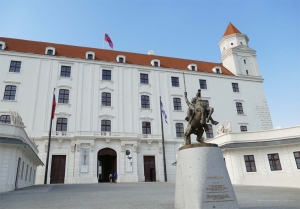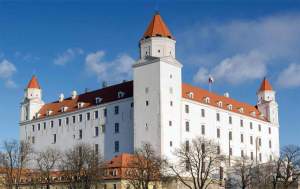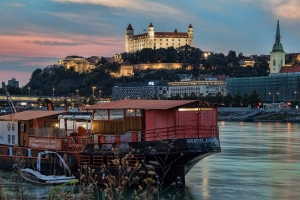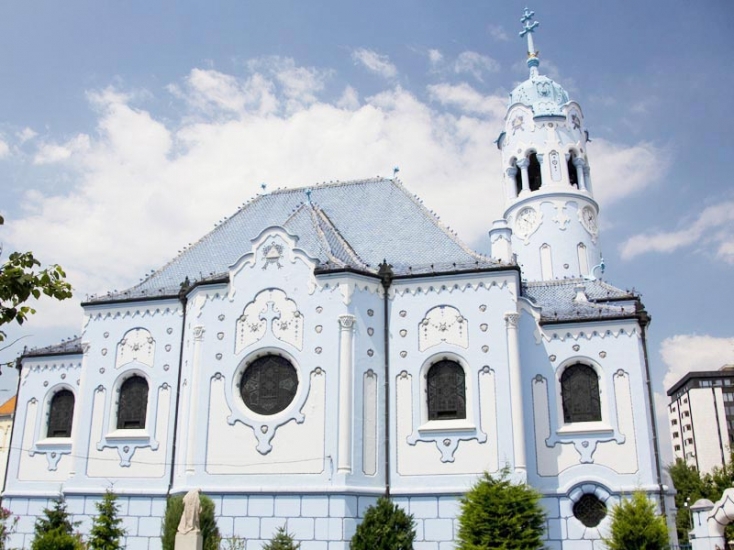Bratislava Castle

Region: Bratislava Region
District: Bratislava I
City / Municipality: Bratislava
City part / Municipality part: Staré Mesto (Old Town)
Tourist location: Bratislava and surroundings (Bratislava a okolie)
Mountains:Little Carpathians (Malé Karpaty)
National cultural Monument
District: Bratislava I
City / Municipality: Bratislava
City part / Municipality part: Staré Mesto (Old Town)
Tourist location: Bratislava and surroundings (Bratislava a okolie)
Mountains:Little Carpathians (Malé Karpaty)
National cultural Monument
The hill, which stands today's Bratislava Castle on, and also the territory of today's city has been inhabited for thousands of years for its strategic location in the center of Europe.
Traces of the oldest settlement come from about 4 500 - 3 500 years from the period of the eneolite (Late Stone Age). Their settlements were built here by the people of Kalenderberg Culture in Hallstatt period (about 850 - 450 years B.C.) During the La Tene period (Younger Iron Age) the castle was inhabited by Celtic culture. Findings at the Bratislava Castle also show the presence of the Romans in the 2nd - 3rd century A.D. Bratislava Castle in the 9th century can be considered as significant Moravian fortress - religious and secular center.
After the fall of Great Moravia there was built castle in place of fortress, which was rebuilt several times in the Middle Ages. The castle was the seat of several kings (e.g. King Solomon, King Imrich, Zigmund Luxemburg, Maria Theresa).
Significant period was the period from the late 16th century until the beginning of the reign of Joseph II (1780). Crown Tower of Bratislava castle was was the place where Hungarian crown jewels were deposited. In the years 1563 - 1830, Bratislava was a coronation town. During this period, 18 kings and queens were crowned in Bratislava.
Important period of building development began during the reign of Sigismund of Luxembourg in the years 1387 - 1437.Bratislava castle passed through Renaissance reconstruction in 1552 - 1562. The great architectural period of the castle was during the reign of Maria Theresa. Rebuilding of the castle was realized by important builders of its time (the period is known as theresian rebuilding of the castle). During this period area was rebuilt for needs of queen's residence and was extened by several annex building, too.
Last comprehensive renovation of the castle took place between 2008 and 2014. It is part of a large-scale reconstruction project of the castle and its surroundings. It also includes restoration of unpreserved parts of the castle, including a northern garden with a garden pavilion. At present time, there are realized futher works at the castle, which started in year 2014.
History of the Bratislava Castle in short
The hill, which stands today's Bratislava Castle on, and also the territory of today's city has been inhabited for thousands of years for its strategic location in the center of Europe.
Eneolit (4 500 - 3 500 years B.C.)
Traces of the oldest settlement come from about 4 500 - 3 500 years from the period of the eneolite (Late Stone Age). People from Boleraz group were the first culture that built a settlement on the area of today's castle hill.
Older Iron Age (850 - 450 years B.C.)
Their settlements were built here by the people of Kalenderberg Culture in Hallstatt period. Kalenderberg Culture belongs to Hallstatt culture (is part of Hallstatt culture). Hallstatt culture, older Iron Age lasted on the territory of today's Slovakia for period about 850 - 450 years B.C..
Celtic Culture (500 - 400 years B.C. - year 1 B.C.)
During the La Tene period (Younger Iron Age) the castle was inhabited by Celtic Culture. The La Tene period (Younger Iron Age) is the period of Celtic Culture also known as La Tene Culture. It lasted about from 500 - 450 B.C. to about year 1 B.C. On the territory of today's Slovakia it was a period of about 500 - 400 B.C. to about year 1 B.C or years 6-10 A.D. Evidence of settlements on todays castle area from this period are traces of oppidum (on today's castle hill and east of it) and the findings of La Tene settlements, as well as the finding of Celtic coins BIATEC. Oppidum, as all Celtic oppidums resembled by its structure and character to medieval city.
Romans (2nd - 3rd century A.D.)
Findings at the Bratislava Castle show the presence of the Romans in the 2nd - 3rd century A.D.. Archaeological works have revealed building materials and some parts of architecture dating back to Roman times.
Great Moravian Empire (Great Moravia) and Slavs (5th - 9th centuries A.D. and Early Middle Ages)
The territory of today's Bratislava and Slovakia has been gradually populated by the Slavs since the 5th century (Slavs are the most numerous ethnic in Europe - the Slovaks also belong to them) and became part of the Great Moravian Empire (Great Moravia). The central territory of the Great Moravian Empire corresponded to the territory of today's Moravia (Czech Republic) and Slovakia along with today's territory of northern and central Hungary. It was the first major Slavic state at all. Today's Slovakia, but also the present Czech Republic (today's Moravia became a part of the Czech Princedom in 1019) consider Great Moravia as the predecessor of their statehood. Bratislava Castle in the 9th century can be considered as significant Moravian fortress - religious and secular center.
High and Late Middle Ages (11th - 16th centuries)
After the demise of the Great Moravian Empire, the Hungarians destroyed seat on the Bratislava castle hill, but they also took advantage of the location and built the castle there. On the remains of the Great Moravian Basilica was built a new church - Holy Saviour Church and Bratislava Canonry (Bratislavská kapitula in slovak language) was founded - the building was later built onto the eastern part of the church. The Bratislava Canonry also fulfilled the role of so-called reliable place, where were transcribed, published, and validated the authentic documents.
In the 70s of the 11th century, the castle was the seat of Solomon, King of Hungary. In the second half of the 12th century a stone Romanesque palace was built on the castle. At the beginning of the 13th century, at the request of King Emeric, the canonry was moved to the area under the castle. In 1221, the church was moved to the place of today's St. Martin's Cathedral. The original temple on the castle was gradually abolished. In years 1241 - 1242 it was a period of the Tartar invasion (invasion of Mongols in Hungary), but Bratislava castle was not conquered.
The reign of Sigismund of Luxembourg (1387 – 1437)
In March 1387 came to the throne of Hungary Sigismund of Luxembourg, one of his decisions was constitution of Bratislava as the new seat of the country. During his reign, important period of building development of Bratislava Castle began. However, other plans for the extensive reconstruction of the castle were destroyed by Sigismund's death in 1437.
Renaissance reconstruction (1552 - 1562)
In 1529, the Ottoman Empire's army conquered Buda, the capital of Hungary. Bratislava became the new capital of the Kingdom. At that time the Habsburgs ruled in Hungary. The Bratislava Castle passed through Renaissance reconstruction in 1552 - 1562. One year after the reconstruction was completed, celebrations related to the crowning of Maximilian II. for the King of Hungary took place at the castle.
From the second half of the 16th century until the time of the reign of Joseph II., Hungarian crown jewels were deposited at the Crown Tower of the castle. In the years 1563 - 1830, Bratislava was a coronation town. During this period, 18 kings and queens were crowned in Bratislava.
Military events of Turkish wars and anti - Habsburg uprisings hit Bratislava Castle, so after 1629 extensive baroque reconstruction was realized on the castle.
The reign of Maria Theresa (1741 - 1780)
On June 25, 1741, there was crowned Maria Theresa (Mária Terézia in Slovak) for the Hungarian Queen in St. Martin's Cathedral in Bratislava. During the reign of Maria Theresa, the Bratislava Castle area was rebuilt for needs of queen's residence and was extened by several annex building.
Loss of importance and destruction
After the death of Maria Theresa in 1780, her son Joseph II became king. He abolished the office of the Hungarian governor and regional offices moved from Pressburg (the name of Bratislava until 1918* ) to Vienna. The castle has lost its use as a representative residence. In 1784 there was a general seminary where the priests of Catholic Church were educated. In 1802, the original representative rooms were adapted in order to house soldiers. In 1809, the Pressburg and the castle was bombarded by cannons by Napoleon's troops, the castle became the target of the French artillery. On 28 May 1811,, the castle burst into huge flames due to carelessness of soldiers. The fire even spread into parts of the town. After the fire the palace was used by the army, too.
Restoration of the castle
Restoration of the Bratislava castle began in 1953. The initiator of the idea was the writer and painter Janko Alexy and the authors of the project were Alfréd Piffl and Dušan Martinček. Reconstruction works were realized in 1956 - 1968 years an aim was to restore the castle from the Terezian period (during the reign of Maria Theresa). The castle became a cultural monument, space for expositions of the Slovak National Museum and the representative spaces of the Slovak National Council were also here.
Another comprehensive renovation of the castle combined with detailed research took place between 2008 and 2014. It is part of a large-scale reconstruction project of the castle and its surroundings to the form as it was after rebuilding during reign of Maria Theresa.
* The name of Bratislava until 1918 was Pressburg in Deutch, Prešporok or Prešporek in Slovak











